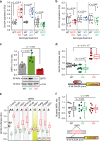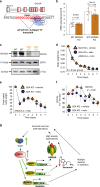SIRT1 accelerates the progression of activity-based anorexia
- PMID: 32499508
- PMCID: PMC7272424
- DOI: 10.1038/s41467-020-16348-9
SIRT1 accelerates the progression of activity-based anorexia
Abstract
Food consumption is fundamental for life, and eating disorders often result in devastating or life-threatening conditions. Anorexia nervosa (AN) is characterized by a persistent restriction of energy intake, leading to lowered body weight, constant fear of gaining weight, and psychological disturbances of body perception. Herein, we demonstrate that SIRT1 inhibition, both genetically and pharmacologically, delays the onset and progression of AN behaviors in activity-based anorexia (ABA) models, while SIRT1 activation accelerates ABA phenotypes. Mechanistically, we suggest that SIRT1 promotes progression of ABA, in part through its interaction with NRF1, leading to suppression of a NMDA receptor subunit Grin2A. Our results suggest that AN may arise from pathological positive feedback loops: voluntary food restriction activates SIRT1, promoting anxiety, hyperactivity, and addiction to starvation, exacerbating the dieting and exercising, thus further activating SIRT1. We propose SIRT1 inhibition can break this cycle and provide a potential therapy for individuals suffering from AN.
Conflict of interest statement
The authors declare no competing interests.
Figures




Similar articles
-
Mechanisms underlying sustained resilience against anorexia nervosa from sub-anesthetic ketamine: A review and new research based on electron microscopic analyses of synapses using a mouse model.Physiol Behav. 2025 Sep 1;298:114956. doi: 10.1016/j.physbeh.2025.114956. Epub 2025 May 20. Physiol Behav. 2025. PMID: 40403996 Review.
-
Deacetylation of MRTF-A by SIRT1 defies senescence induced down-regulation of collagen type I in fibroblast cells.Biochim Biophys Acta Mol Basis Dis. 2020 May 1;1866(5):165723. doi: 10.1016/j.bbadis.2020.165723. Epub 2020 Feb 12. Biochim Biophys Acta Mol Basis Dis. 2020. PMID: 32061777
-
Sirt1 promotes autophagy and inhibits apoptosis to protect cardiomyocytes from hypoxic stress.Int J Mol Med. 2019 May;43(5):2033-2043. doi: 10.3892/ijmm.2019.4125. Epub 2019 Mar 6. Int J Mol Med. 2019. PMID: 30864731 Free PMC article.
-
SIRT1-PGC1α-NFκB Pathway of Oxidative and Inflammatory Stress during Trypanosoma cruzi Infection: Benefits of SIRT1-Targeted Therapy in Improving Heart Function in Chagas Disease.PLoS Pathog. 2016 Oct 20;12(10):e1005954. doi: 10.1371/journal.ppat.1005954. eCollection 2016 Oct. PLoS Pathog. 2016. PMID: 27764247 Free PMC article.
-
[Hyperactivity and anorexia nervosa: behavioural and biological perspective].Encephale. 2004 Sep-Oct;30(5):492-9. doi: 10.1016/s0013-7006(04)95463-2. Encephale. 2004. PMID: 15627053 Review. French.
Cited by
-
Multi-omic profiling of the developing human cerebral cortex at the single-cell level.Sci Adv. 2023 Oct 13;9(41):eadg3754. doi: 10.1126/sciadv.adg3754. Epub 2023 Oct 12. Sci Adv. 2023. PMID: 37824614 Free PMC article.
-
Activity-Based Anorexia Dynamically Dysregulates the Glutamatergic Synapse in the Nucleus Accumbens of Female Adolescent Rats.Nutrients. 2020 Nov 28;12(12):3661. doi: 10.3390/nu12123661. Nutrients. 2020. PMID: 33260714 Free PMC article.
-
Association of SIRT1 single gene nucleotide polymorphisms and serum SIRT1 levels with laryngeal squamous cell carcinoma patient survival rate.Cancer Biomark. 2022;34(2):175-188. doi: 10.3233/CBM-210264. Cancer Biomark. 2022. PMID: 34719479 Free PMC article.
-
From gut microbiota to host appetite: gut microbiota-derived metabolites as key regulators.Microbiome. 2021 Jul 20;9(1):162. doi: 10.1186/s40168-021-01093-y. Microbiome. 2021. PMID: 34284827 Free PMC article. Review.
-
SIRT1 Coordinates Transcriptional Regulation of Neural Activity and Modulates Depression-Like Behaviors in the Nucleus Accumbens.Biol Psychiatry. 2024 Sep 15;96(6):495-505. doi: 10.1016/j.biopsych.2024.03.017. Epub 2024 Apr 3. Biol Psychiatry. 2024. PMID: 38575105
References
-
- Treasure J, et al. Anorexia nervosa. Nat. Rev. Dis. Prim. 2015;1:15074. - PubMed
-
- Davis C. Excessive exercise and anorexia nervosa: addictive and compulsive behaviors. Psychiat Ann. 1999;29:221–224.
-
- McNulty PA. Prevalence and contributing factors of eating disorder behaviors in active duty service women in the Army, Navy, Air Force, and Marines. Mil. Med. 2001;166:53–58. - PubMed
Publication types
MeSH terms
Substances
Grants and funding
LinkOut - more resources
Full Text Sources
Molecular Biology Databases
Miscellaneous

